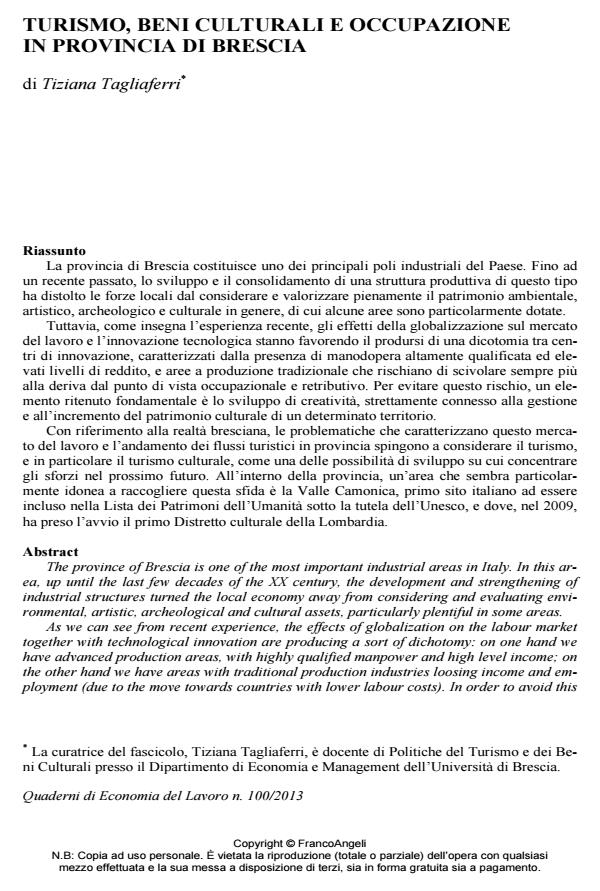Turismo, beni culturali e occupazione in provincia di Brescia
Journal title QUADERNI DI ECONOMIA DEL LAVORO
Author/s Tiziana Tagliaferri
Publishing Year 2013 Issue 2013/100
Language Italian Pages 57 P. 21-77 File size 800 KB
DOI 10.3280/QUA2013-100003
DOI is like a bar code for intellectual property: to have more infomation
click here
Below, you can see the article first page
If you want to buy this article in PDF format, you can do it, following the instructions to buy download credits

FrancoAngeli is member of Publishers International Linking Association, Inc (PILA), a not-for-profit association which run the CrossRef service enabling links to and from online scholarly content.
The province of Brescia is one of the most important industrial areas in Italy. In this area,up until the last few decades of the XX century, the development and strengthening ofindustrial structures turned the local economy away from considering and evaluating environmental,artistic, archeological and cultural assets, particularly plentiful in some areas.As we can see from recent experience, the effects of globalization on the labour markettogether with technological innovation are producing a sort of dichotomy: on one hand wehave advanced production areas, with highly qualified manpower and high level income; onthe other hand we have areas with traditional production industries loosing income and employment(due to the move towards countries with lower labour costs). In order to avoid this risk, it is essential to develop creativity and this is closely related to the management andthe increase in value of the cultural patrimony in a given area.Talking about the province of Brescia, the set of problems which characterize its labourmarket as well as the evolution of its incoming touristic flows suggest concentrating effortson tourism, specially cultural tourism, as a possibility of development in the near future.Amongst the various areas of which the province of Brescia is made up, Valle Camonica isthe one which seems better suited to reach this target: it was the first Italian site included inthe UNESCO World Heritage List and where the first Cultural District project in Lombardiastarted
- Il turismo culturale come opportunità per il mercato del lavoro bresciano Tiziana Tagliaferri, in QUADERNI DI ECONOMIA DEL LAVORO 105/2017
DOI: 10.3280/QUA2016-105011 - Relationships between Heritage, Intangible Capital and Cultural and Creative Industries in Italy: A Framework Analysis for Urban Regeneration and Territorial Development Maria Immacolata Simeon, Assunta Martone, in Advanced Engineering Forum /2014 pp.149
DOI: 10.4028/www.scientific.net/AEF.11.149
Tiziana Tagliaferri, Turismo, beni culturali e occupazione in provincia di Brescia in "QUADERNI DI ECONOMIA DEL LAVORO" 100/2013, pp 21-77, DOI: 10.3280/QUA2013-100003